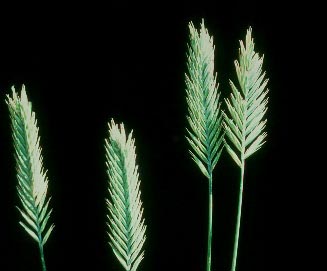Crested Wheatgrass

Common Name(s):
Crested Wheatgrass
Scientific Name:
Agropyron cristatum (L.) Gaertn.
Scientific Name Synonyms:
None known
Symbol:
AGCR
Description:
Life Span: Perennial
Origin: Introduced
Season: Cool
Growth Characteristics:A perennial bunchgrass, without rhizomes, growing to a height of 1 ½ to 2 ½ feet. It starts growth in early spring and flowers in late spring. It reproduces from seeds and tillers. It may regrow in the fall if moisture is sufficient.
Seedhead:A dense spikelet, with a conspicuously flattened head, 1 ½ to 3 inches long, tapering toward the tip; spikelets numerous, overlapping and placed flat-wise on the rachis, contain 4 to 8 florets per spikelet; glumes about half the length of the spikelet; both the glumes and lemmas usually taper to a point or into a short awn.
Leaves: Leaf blades flat, vary in fineness with the vigor of the plant, usually glabrous; sheaths glabrous or pubescent on lower leaves; leaves rolled in the bud; ligules short and membranous; auricles short, pointed and clasping the stem.
Ecological Adaptions:
Various varieties of crested wheatgrass were introduced from Russia in the 1930's. They are adapted to elevations ranging from 4000 to 8000 feet in Utah. All varieties are very resistant to fire, drought, cold temperatures, and heavy grazing.
Soils: Adapted to well-drained, loamy soils where precipitation is 8 inches or more annually. Grows vigorously on a wide variety of soils. Crested Wheatgrass varieties have been seeded more extensively than any other species in Utah and the colder part of the West. Moderate salt tolerance. Alkali tolerance in certain varieties. Low resistance to high water tables, especially in the winter.
Associated Species: Widespread
Uses and Management:
Crested wheatgrass provides good forage value for all classes of livestock, and fair for wildlife. It cures well for use as winter forage, but must be supplemented with phosphorus and /or protein as needed. It is most valuable for early spring grazing for livestock and wildlife. It is choice feed for deer during the spring, and elk in the winter, providing a good source of energy. Proper grazing use on better sites is 60 to 65 percent during growth period and 70 percent during dormant periods. Crested wheatgrass is excellent for soil protection and is used for fast and reliable rehabilitation of watersheds. It is very competitive and can often be used to suppress cheatgrass. It is susceptible to herbivory if it is repeatedly grazed during it's stem elongation growth phase every year. If alternately rested, it has been shown to be highly resistant to grazing.

